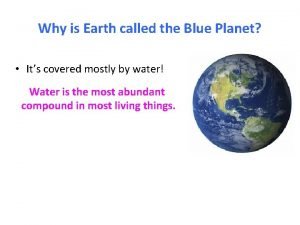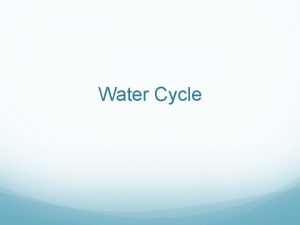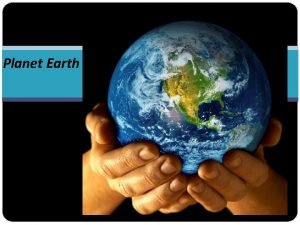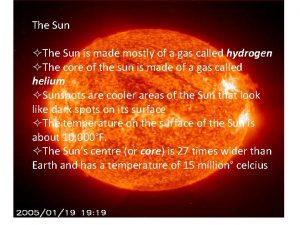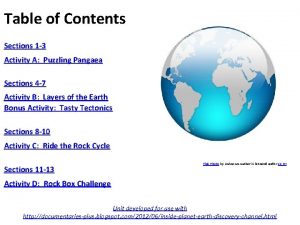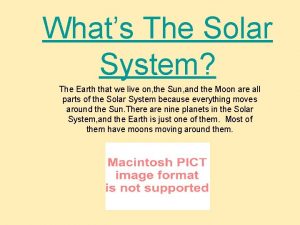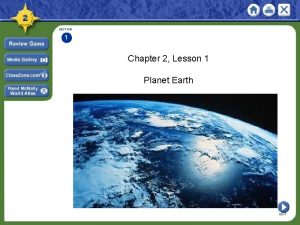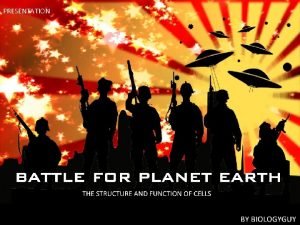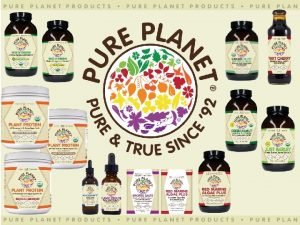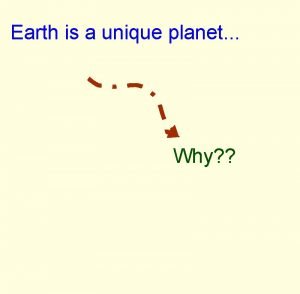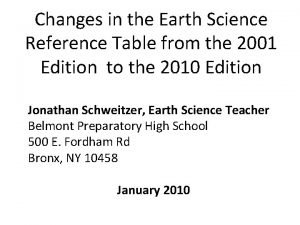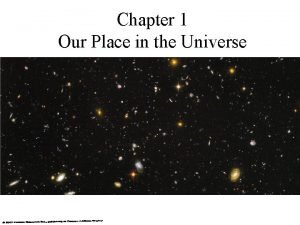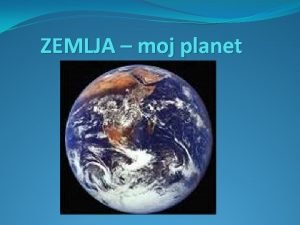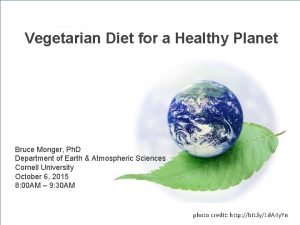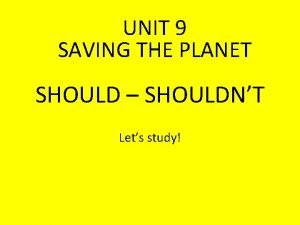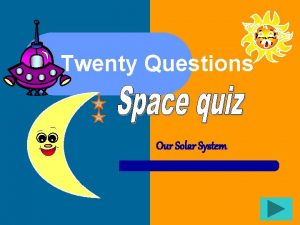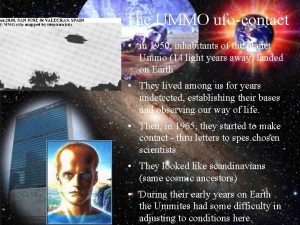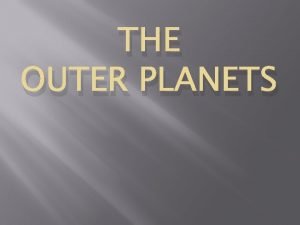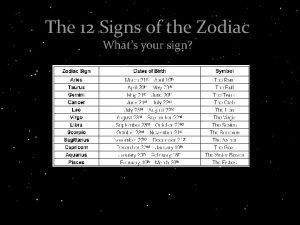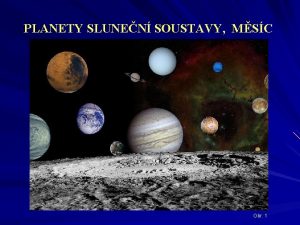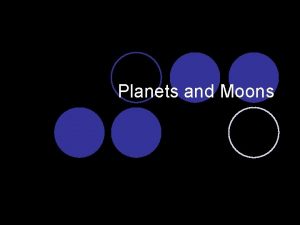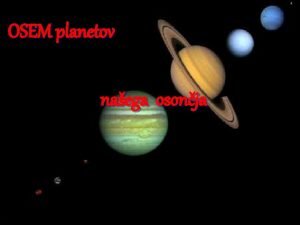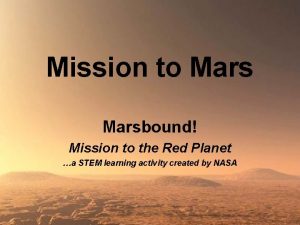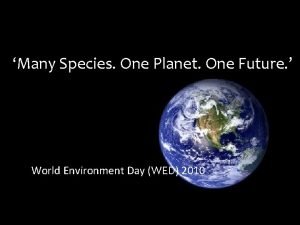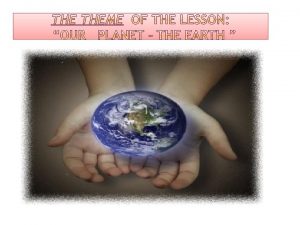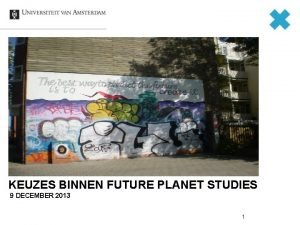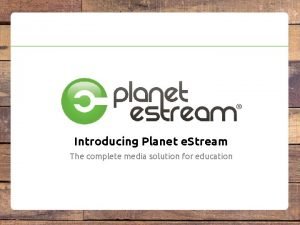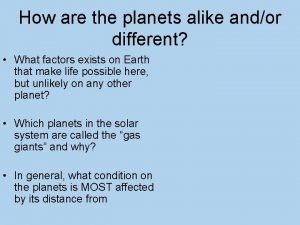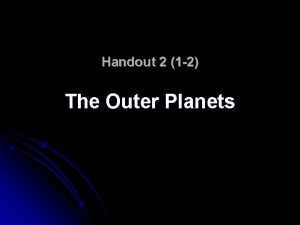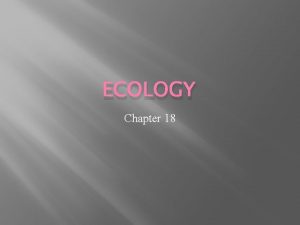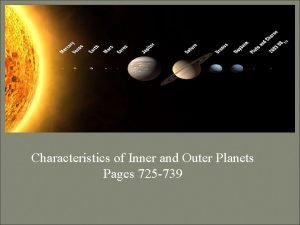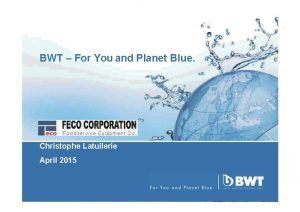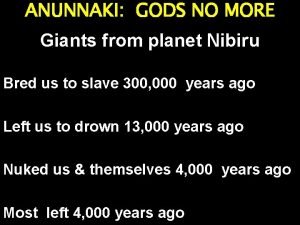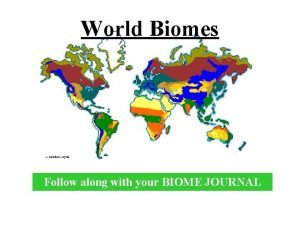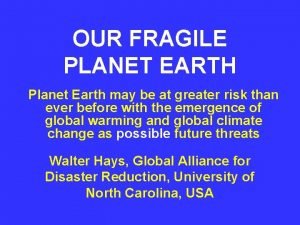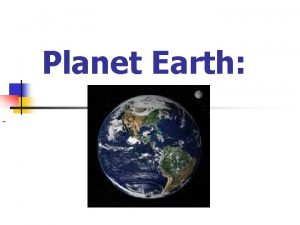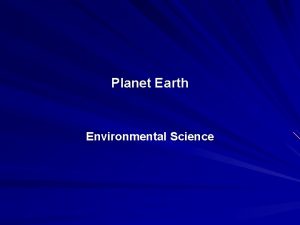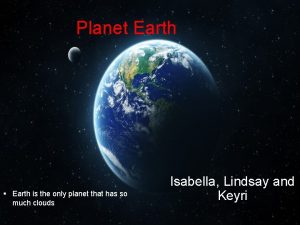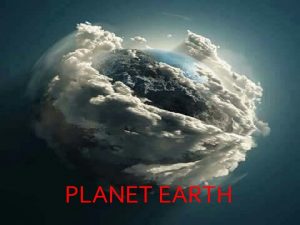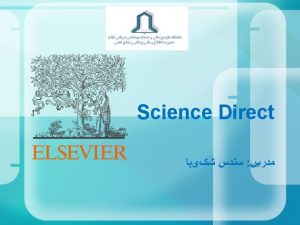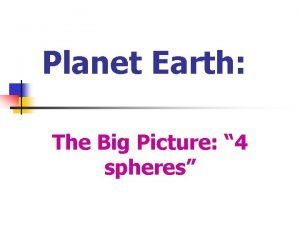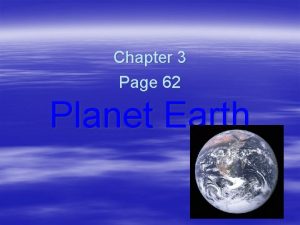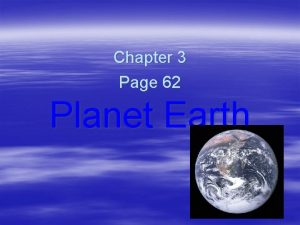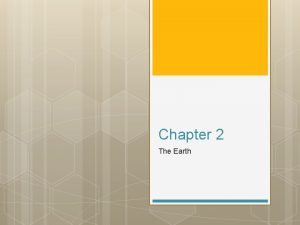Chapter 3 Page 62 Planet Earth Is Earth

























































- Slides: 57

Chapter 3 Page 62 Planet Earth

Is Earth open or closed? The Earth is a closed system. For our examples, we need to think that nothing comes in (except energy) and nothing goes out (except energy).

Natural Resources? They are the basis of life on earth. These things include water (seas and fresh water), land, soils, rocks, forests (vegetation), animals (including fish), fossil fuels and minerals. All these mentioned above are natural, and they exist in nature. No human created them. We have a finite amount of these materials on this planet. Not only are humans using these materials, but nature is using them too. The difference between humans and nature is that nature doesn't waste. Materials are cycled through the ecosystems of the Earth and reused whenever possible.

The Earth as a System The Earth is an integrated system that consists of rock, air, water, and living things that all interact with each other. Scientists divided this system into four parts: • • The The Geosphere (rock) Atmosphere (air) Hydrosphere (water) Biosphere (living things)

Biodiversity = “the variety of life in the world or in a particular habitat or ecosystem” Biodiversity is extremely important to people and the health of ecosystems. A few of the reasons are: • It provides us with an array of foods and materials • cure diseases and lengthen life spans • new vaccine or drug. • Adjust to disturbance in nature • Biodiversity is an important part of ecological services that make life livable on Earth. They include everything from cleaning water and absorbing chemicals, which wetlands do, to providing oxygen for us to breathe—one of the many things that plants do for people. • Biodiversity allows for ecosystems to adjust to disturbances like extreme fires and floods. If a reptile species goes extinct, a forest with 20 other reptiles is likely to adapt better than another forest with only one reptile. • Genetic diversity prevents diseases and helps species adjust to changes in their environment.

Sustainability is important to making sure that we have and will continue to have the water, materials, and resources to protect human health and our environment.

Chapter 3 Section 1 The Geosphere The Earth as a System The geosphere is the mostly solid, rocky part of the Earth that extends from the center of the core to the surface of the crust”

Chapter 3 Section 1 The Geosphere The Composition of the Earth’s • • • three layers: The crust The mantle The core These layers are made up of progressively denser material toward the center of the Earth.

Chapter 3 Section 1 The Geosphere The Composition of the Earth The crust is the thin and solid outermost layer of the Earth above the mantle. Outermost layer is called the LITHOSPHERE.

CHANGES IN THE LITHOSPHERE Made of several large, movable plates called TECTONIC PLATES that are naturally moving. Their edges are called BOUNDARIES.

Chapter 3 Section 1 The Geosphere Where do Earthquakes Occur?

Plate Boundaries: 1. Convergent - explosive POLLUTING volcanoes 2. Divergent – volcanoes/seafloor spreading 3. Transform – DESTRUCTIVE EQ

Earthquake impacts EQ destroy existing structures. To rebuild this is a waste of resources. Also disasters destroy natural ecosystems.

San Francisco

Volcano natural pollution impacts Have natural carbon emissions into the atmosphere! Hurts the water quality Changes the temperature by blocking out the sun! Releases SO 2 which causes acid rain and acidic bodies of water! . During and eruption, volcanic ash can mix with water and produce mudflow that runs downhill. In addition, ash that falls to the ground can cause buildings to collapse under its weight, bury crops, damage the engines of vehicles, and cause breathing difficulties

Deadly Volcanic ash clouds

Erosion Chapter 3 Section 1 The Geosphere The Earth’s surface is continually battered by wind and scoured by running water, which moves rocks around and changes their appearance. Erosion is the process in which the materials of the Earth’s surface are loosened, dissolved, or worn away and transported form one place to another by a natural agent, such as wind, water, ice or gravity. Erosion wears downs rocks and makes them smoother as times passes. Older mountains are therefore smoother than younger ones.

Chapter 3 Section 1 The Geosphere Water Erosion by both rivers and oceans can produce dramatic changes on Earth’s surface. Waves from ocean storms can erode coastlines to give rise to a variety of landforms, Over time, rivers can carve deep gorges into the landscape.

Chapter 3 Section 1 The Geosphere Wind Erosion Wind also changes the landscape of the planet. In places where few plants grow, such as beaches and deserts, wind can blow soil away very quickly. Soft rocks, such as sandstone, erode more easily than hard rocks, such as granite do.

All 3 places make up the… BIOSPHERE “All parts of the earth that support and contain life” Found in 3 places: Geosphere Hydrosphere Atmosphere

Chapter 3 Standardized Test Prep Multiple Choice 1. What is the cool, rigid, outermost layer of the Earth? A. the B. the C. the D. the asthenosphere geosphere lithosphere mesosphere

Chapter 3 Standardized Test Prep Multiple Choice, continued 2. The collision of tectonic plates creates what geologic feature? A. earthquakes B. faults C. mountains D. volcanoes

Chapter 3 Standardized Test Prep Multiple Choice, continued 2. The collision of tectonic plates creates what geologic feature? A. earthquakes B. faults C. volcanoes

Day 2

3. 2 Atmosphere The atmosphere is a mixture of gases that surrounds a planet, such as Earth.

Section 2 The Atmosphere Composition of the Atmosphere Nitrogen Oxygen In - 78 % 21 % addition to gases, the atmosphere contains many types of tiny, solid particles, or atmospheric dust.

Chapter 3 Section 2 The Atmosphere Layers of the Atmosphere The atmosphere is divided into 4 -5 layers based on temperature changes that occur at different distances above the Earth’s surface. • Troposphere • Stratosphere • Mesosphere • Thermosphere

Troposphere (touches earth) Importance: Has most of the gas molecules Has most of water vapor Most weather occurs here

Unfortunately…. This is also where our pollution accumulates, as well as our heat that is being trapped.

The Stratosphere (Second layer) Ozone is a gas molecule that is made up of three oxygen atoms. . Contains: 90% of OZONE LAYER Because ozone absorbs UV radiation, it reduces amount of UV radiation that reaches the Earth. UV radiation that does reach Earth can damage living cells.

Ultraviolet Light The sun produces UV, which is commonly split into three bands: UVA, UVB, and UVC. UVA is not absorbed by ozone. UVB is mostly absorbed by ozone, although some reaches the Earth. UVC is completely absorbed by ozone and normal oxygen.

The Mesosphere (middle layer) above To the stratosphere. about 80 km. This is the coldest layer of the atmosphere where temperatures have been measured as low as – 93ºC.

THERMOSPHERE/IONOSPHERE Ions then reunite with electrons and makes LIGHT! HOT! Happens at the poles Called AURORA LIGHTS North Pole = Aurora Borealis South Pole = Aurora Australis

Exosphere (exiting Earth) The atmosphere merges into space in the extremely thin exosphere. This is the upper limit of our atmosphere.

Section 2 The Atmosphere Energy Transfer in the Atmosphere is the energy that is transferred as electromagnetic waves, such as visible light and infrared waves. Radiation is the transfer of energy as heat through a material. Conduction is the movement of matter due to differences in density that are caused by temperature variations an can result in the transfer of energy as heat. Convection

Chapter 3 Section 2 The Atmosphere Energy Transfer in the Atmosphere

Section 2 The Atmosphere Heating of the Atmosphere Solar energy reaches the Earth as electromagnetic radiation, which includes visible light, infrared radiation, and ultraviolet light. About half of the solar energy that enters the atmosphere passes through it and reaches the Earth’s surface, while the rest of the energy is absorbed or reflected in the atmosphere by clouds, gases, and dust or it is reflected by Earth’s surface.

Section 2 The Atmosphere Heating of the Atmosphere The Earth does not continue to get warmer because the oceans and the land radiate the absorbed energy back into the atmosphere. Dark-colored objects absorb more solar radiation that light-colored objects, so dark colored objects have more energy to release as heat. This is one reason the temperature in cities is higher that the temperature in the surrounding countryside.

What would happen if Earth’s white ice caps begin to melt?

Atmospheric Pollution

Greenhouse Effect Gases trap heat inside the atmosphere. This heat that radiates in is not able to radiate back out. Without the greenhouse effect, the Earth would be too cold for life to exist.

Chapter 3 Section 2 The Atmosphere The Greenhouse Effect

Chapter 3 Section 2 The Atmosphere The Greenhouse Effect The most abundant greenhouse gases are water vapor, carbon dioxide, methane, and nitrous oxide, although none exist in high concentrations. The quantities of carbon dioxide and methane in the atmosphere vary considerable as a result of natural and industrial processes.

Global Warming

Ozone layer Is thinning! More prominent over the poles. Not able to protect us from some of the UV

Day 3

Hydrosphere = water portion of earth Roughly 71%

Types of water - the difference is the amount of salt they contain. Fresh Lakes, rivers, streams, puddles, ponds, wetlands, marshes Salty Oceans, wetlands, marshes

Where is all of our water? https: //www. youtube. c om/watch? v=4 HSFKwho 7 MQ

Locations of water Surface Ground: = “water that is located on the surface (above ground) of the earth” = “Water that is located under/in the ground” - Found in Aquifers

Aquifers Water can stay here for 1, 000’s of years!

Issues with our water…

Water cycle “The continuous movement of water into the air, onto land, and then back to water sources”

4 parts of the water cycle 1. Evaporation 2. Condensation 3. Precipitation 4. transpiration

Why water? Life on earth could not exist without water for obvious reasons! But…. another thing large bodies of water does for the planet is retain heat! This keeps earth at a steady temperature instead of completely depending on outside heat!

Why care about water? http: //video. nationalgeographic. com/video/envfreshwater-whycare? source=searchvideo

Biosphere “The narrow layer around Earth’s surface in which life can exist” Uppermost part of geosphere, most of hydrosphere and lower part of atmosphere If compared to an apple, it would be the small layer of skin. Life exists because of our: Water Moderate temperatures A Source of energy
 Why earth is called blue planet
Why earth is called blue planet Apa introduction example
Apa introduction example Water cycle infiltration
Water cycle infiltration Does the sun moves
Does the sun moves The sun is made mostly of
The sun is made mostly of Inside planet earth video worksheet answers
Inside planet earth video worksheet answers Whats the biggest planet in the solar system
Whats the biggest planet in the solar system Lesson 1 planet earth
Lesson 1 planet earth Battle for planet earth
Battle for planet earth Planet earth and beyond grade 4
Planet earth and beyond grade 4 Pure planet fulvic zeolite
Pure planet fulvic zeolite Why is the earth called unique planet
Why is the earth called unique planet Part d earth science regents
Part d earth science regents Earth science reference table page 16
Earth science reference table page 16 Sit on the planet chapter 1
Sit on the planet chapter 1 Page.php?chapter=
Page.php?chapter= Chapter 4 performing basic vehicle maneuvers
Chapter 4 performing basic vehicle maneuvers Page.php?chapter=
Page.php?chapter= To kill a mockingbird chapter 5
To kill a mockingbird chapter 5 Inurl:page.php?file=
Inurl:page.php?file= Chapter 15 assessment biology answers page 445
Chapter 15 assessment biology answers page 445 Chapter 1 tools of geometry answer key page 54
Chapter 1 tools of geometry answer key page 54 Obujam zemlje
Obujam zemlje Animal planet schedule
Animal planet schedule Dr bruce monger
Dr bruce monger What do you do to protect the environment
What do you do to protect the environment What's the hottest planet
What's the hottest planet Ummites
Ummites Terrestrial planets surface
Terrestrial planets surface Outer planets
Outer planets What are the outer planets mostly made of
What are the outer planets mostly made of Star life cycle from birth to death
Star life cycle from birth to death Endless summer ram scorpion bull lion
Endless summer ram scorpion bull lion What is the largest planet known
What is the largest planet known Pořadí planet
Pořadí planet Mercury planet features
Mercury planet features Planet fitness internship
Planet fitness internship Wady pkb jako miernika
Wady pkb jako miernika What is each planet made of
What is each planet made of Osmi planet od sonca
Osmi planet od sonca Marsbound mission to the red planet
Marsbound mission to the red planet One futureworld
One futureworld The earth is my home i promise to keep it song lyrics
The earth is my home i promise to keep it song lyrics Future planet studies
Future planet studies Planet e stream
Planet e stream Ibm smarter planet strategy
Ibm smarter planet strategy Hungry planet
Hungry planet How are the inner and outer planets alike?
How are the inner and outer planets alike? Hiphop planet
Hiphop planet Matching planet rings
Matching planet rings Studying our living planet
Studying our living planet Planet.com.tw
Planet.com.tw Characteristics of outer planets
Characteristics of outer planets For you and planet blue
For you and planet blue Nibiru giants
Nibiru giants Planet ata
Planet ata Planet beruf de
Planet beruf de Tropical savanna adaptations
Tropical savanna adaptations
